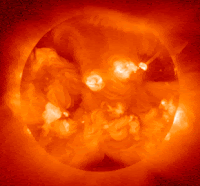Description: In this album we are going to learn about the solar system, the eight planets and the sun.
1.The solar system: The solar system consist of the sun and those celestial objects bound to it by gravity,all of wich were formed from the collapse of a giant molecular cloud aproximately 4.6 billion years ago.
2.Sun: The sun is the star at the center of the solar system.It has a diameter of about 1,392,000 kilometers (865,000 mi) about 109 times that of earth,and its mass.
3.Mercury: Mercury is the innermost and smallest planet in the solar system,orbiting the sun once every 87.969 earth days.
4.Venus: Venus is the second planet from the sun,orbiting every 224.7 earth days.The planet is named after Venus,the Roman goddness of love and beauty.
5.Earth: Earth is the third planet from the sun,and the denset and fifth-largest of the eight planets in the solar sys
tem. It is also the largest of the solar system"s four terrestrial planets.
6.Mars: Mars is the fourth planet in the solar system.The planet is named after the Roman god of wars,Mars.It is often described as the red planet,as the iron oxide prevalent on its surface gives it as a reddish appearance.
7.Jupiter: Jupiter is the fifth planet from the sun and the largest planet within the solar system.It is a gas giant with a mass slightly less than one-thousandth of the sun but is two a half times the mass of all other planets in our solar system combined.
8.Saturn: Saturn is the sixth planet from the sun and the second largest planet in the solar system,after Jupiter.Saturn is named after the Roman god Saturn.
9.Uranus: Uranus is the seventh planet from the sun,and the third-largest and fourth most massive planet in the solar system.
10.Neptune: Neptune is the eight and farthest planet from the sun in our solar system.Named for the Roman god of the sea,it is the fourth-largest planet by diameter and the third-largest by mass.
Conclusion: I learn that the Earth is the only planet from the eight that can hold life because we are in the right distance from the Sun,that the Sun is a star,that the Moon is a satellite and that Pluto is don"t considered a planet because is too small and because his orbit meet Neptune"s orbit.















































